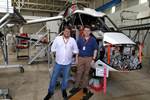Uavos OEM program enables high-efficiency CFRP rotor blades
Development of new all-composite helicopter retrofit blades with stainless steel leading edges highlights the company’s focus on greater operational efficiency and high resistance to harsh environments.
Source | Uavos
(Mountain View, Calif., U.S.) announces that it has developed a new version of its carbon fiber-reinforced polymer (CFRP) rotor blade for helicopters with up to 140 kilograms of takeoff mass. The retrofit blades, which offer reduced maintenance and higher performance than previous options include a leading edge with stainless steel, high twist distributions and a modern airfoil. The metal leading edge improves protection when operating in sand, rain, saltwater and other harsh environments.
The blades were designed with multiple prepreg layers, each of which is applied in a specific pattern and orientation and cured in an oven. Uavos says that its technology ensures maximized strength and matches the mechanical properties of the composite design, delivering blades with an improved production cycle, reduced initial and life cycle operating costs, as well as fuel savings and performance gains.
“Rotor blades are subjected to the toughest stresses during operation,” says Aliaksei Stratsilatau, CEO of Uavos. “They must be able to withstand any weather conditions. For this reason, the highest quality requirements apply to the manufacturing process — especially to the materials.”
Uavos’ capabilities include bringing a rotor blade project through preliminary design, prototyping, bench testing, test certification and manufacturing. The company’s facilities include a composites fabrication shop, a fatigue test rig capable of testing blades, a CNC machine shop, ovens, a heated press, automatic ply cutting and a large material freezer, enabling Uavos to develop rotor blades internally quickly.
“The Uavos OEM program shows our commitment to innovation and next-generation programs for the unmanned platforms,” adds Stratsilatau. “As an OEM provider and UAV operator, Uavos continues to push the envelope to find new and reliable solutions.”
Related Content
-
Otto Aviation launches Phantom 3500 business jet with all-composite airframe from Leonardo
Promising 60% less fuel burn and 90% less emissions using SAF, the super-laminar flow design with windowless fuselage will be built using RTM in Florida facility with certification slated for 2030.
-
Automated robotic NDT enhances capabilities for composites
Kineco Kaman Composites India uses a bespoke Fill Accubot ultrasonic testing system to boost inspection efficiency and productivity.
-
Plant tour: Airbus, Illescas, Spain
Airbus’ Illescas facility, featuring highly automated composites processes for the A350 lower wing cover and one-piece Section 19 fuselage barrels, works toward production ramp-ups and next-generation aircraft.






